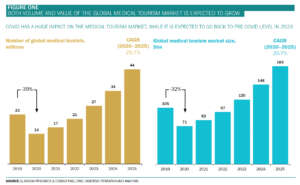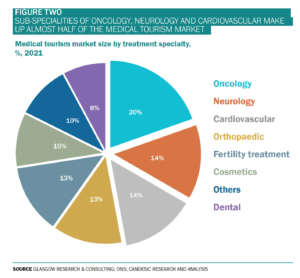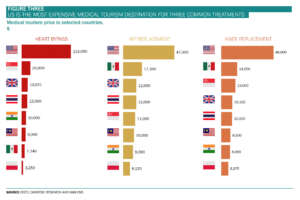The World Health Organisation estimates the medical tourism market to be worth US$100bn, on the verge of explosive growth, and forecast to expand 25% per year over the next 10 years. Questions remain as to who the winners in this market will be and whether consumers will focus on outcomes, location or price. Dr Michelle Tempest, Candesic partner and Alina Trabattoni, Candesic expert, discuss growth prospects in the industry.
Go anywhere in the world and it’s evident that Covid has had a dramatic impact on healthcare ecosystems. Information and access to vaccines and PCR tests have exploded but waits for elective surgery are getting longer and longer. Healthcare systems have been left to negotiate the toxic trio of a global pandemic, an aging population and more long-term conditions.
Mavis, a 72-year old lady from Galway, Ireland said, “I’ve been waiting over six months to get my knee replaced. I’m in pain and struggle to play with my grandchildren – I can wait no more. I’m now looking to travel abroad for surgery.
“Is this what I want to do? No, my daughter says she worries about me travelling solo and undergoing an anaesthetic in a foreign country. But what other option do I have? Life is passing me by.”
She is one of the many tens of thousands of outbound medical tourists from Europe who are scanning the internet for fast knee replacement options – searching on Google in a similar way to booking flights on Skyscanner.
Patient pools
The practise of ‘medical tourism’, also termed ‘health tourism’ by some, is not limited to Europe, but also involves an ever-growing pool of patients from the US and other developed nations that suffer from high costs of medical treatment. These difficulties are increasingly pushing urgent-need medical patients, as well as those seeking aesthetic treatments including plastic surgery and hair transplants, abroad for treatment.
Ever-increasing treatment costs in one’s home country and long waits are two distinctive factors that motivate people to travel abroad for medical purposes. Another draw seems to be the offer of high-quality outcomes.
The result: a boom in the medical tourism industry.
Sector analysts predict the industry is on the verge of explosive growth (Figure 1). Crossing borders in pursuit of better health is forecast to jump some 25% per year over the next ten years, according to VISA/Oxford Economics data, but to what cost for consumers and health care system worldwide?

Pre-Covid health tourism demand tended to originate from individuals seeking treatment and surgery left uncovered by health insurance in their countries. This frequently included procedures like cosmetic surgery (breast and liposuction), obesity surgery and infertility treatment. Some travelled abroad for ethical or privacy concerns around transgender procedures. Others travelled abroad incentivised by health insurances seeking quicker procedures for patients waiting for organ transplants as well as urgent oncology, neurology or cardiac care (Figure 2).

“Medical tourism is a phenomenon that responds to the request for a private, rapid and efficient health service by some segments of the middle class of advanced countries. One that can be provided at a lower cost than in the country of origin,” said Dr Gloria Taliani, Professor of Infectious Diseases at the Sapienza University in Rome, Italy. “As such, it’s a phenomenon that is destined to grow.”
Dental treatments, plastic surgery “and in general all surgery that is not of an urgent or complex nature” are among common procedures, according to Dr Taliani.
Expansion plans
In 2019, there were some 23 million people seeking medical care abroad, according to Glasgow Research & Consulting. Post-pandemic industry data varies widely, and calculations are further complicated by the non-obligatory registration of non-resident patients in many nations, as well as different understandings of key concepts and methods for estimating market size. Even so, most analysts agree there is no question the market is undergoing a process of strong expansion, one which is set to continue in coming years as populations of developing nations grow older and overburden national healthcare systems.
Some analysts go as far as to indicate the medical tourism market worldwide will speed up its growth this year and in the coming two years, to almost double in size to some US$180bn worldwide by 2025 (the Korea Health Industry Development Institute.)
Considering the massive growth potential of the sector worldwide, there has been a flurry of policy announcements from governments including those of Singapore, Thailand, Malaysia, India, and Turkey – amongst others – promising to revive their medical tourism industries to bolster planned economic growth.
Silver lined patients
A silver lining of the medical tourism market is that sector services also filter down to boost national gross domestic product with its impact felt well beyond the medical sector thanks to revenue generated by health tourism agencies, property rentals, transport, travel, catering, and post-surgery and housekeeping care services that accompany patients throughout their medical journey abroad. In parallel, private investors in recipient nations such as Turkey, Mexico and Singapore have also initiated strong investment flows into the sector, especially from Americans trying to find cheaper locations (Figure 3).

Amongst the factors that determine the viability of a destination for medical tourism is the existence of a safe and secure environment, the presence of well-established hospitals, the availability of qualified doctors, and the presence of favourable climate conditions - as well as overall cost-attractiveness. Many of the nations with a bourgeoning medical tourism sector, such as Turkey, are introducing regulation and actively investing in cutting-edge medical centres in a bid to capture a greater slice of the global market.
Turkey case study
In recent years investments in new hospital builds have led Turkey’s healthcare system to flourish, drawing patients from all over the world in search of affordable care and turning it into a major destination for medical tourism. In past years, the government, in a bid to promote local medical services to international patients, went as far as to offer a 50% discount to medical tourists on flight tickets purchased on state-owned Turkish Airlines. More recently it launched a programme offering weekly medical tours from the US at a flat-fee cost of US$5,000.
Turkey’s natural and cultural attractions also help draw in medical tourists that want to enjoy a location that is also a popular tourist destination. Those in need of medical care that also wish to enjoy a holiday often consider the Turkey option as, thanks to its historical, cultural and natural offerings, the nation attracts many visitors for post-treatment recover holidays.
“So if you feel confident enough, you’re more than welcome to hop on a plane, and come to Turkey, because I believe that’s going to be a very nice experience,” said Prof Mehmet Veli Karaaltin, a plastic surgeon who also oversees many of the hair transplant operations of the Acibadem hospital group. “It’s not like coming to Turkey is going to be a leap of faith. It’s more like a nice adventure.”
Plastic surgery and hair transplants combine with dental care, cosmetic surgery, electric surgery, hair transplants, in-vitro fertilisation, eye surgery, cardiology and cardiovascular surgery, orthopaedics and traumatology as some of the treatments available in Turkish hospitals for non-resident tourists.
The recently formed Turkish state-owned International Health Services (USHAS) promotes and regulates health tourism in a nation that touts high quality certified staff, excellent hospitals, and a welcoming atmosphere, in a bid to earn Turkey a reputation as an important medical tourism hub.
Many self-pay medical procedures can be cheaper in countries like Turkey than in the US, the UK or the European Union, and the government has also established tax-free healthcare zones to lure international visitors for medical procedures. Some agencies like WeCure, which specialises in organising incoming medical tourism to large hubs like Turkey, also offer instalment payment schemes to lighten the load of health costs on patients already suffering the effects of today’s higher cost of living.
Exact data and reliable growth forecasts, in terms of overall medical procedures for health tourism patients, are difficult to come by due to variations in calculations. Many analysts argue the state is not aware of the full medical tourism figures, which include many hundreds of thousands unregistered hair transplants and dental procedures. Even so, state-owned healthcare provider USHAT has calculated that some US$1.6bn in medical tourism fees flowed into Turkey in the first nine months of 2022, as some 870,000 people travelled to the nation for medical care.
Looking forward, the government’s Vision 2023 plan, which was unveiled before the pandemic, aims to increase the number of inbound health tourists to some two million a year.
Delve deeper
Down sides to seeking medical treatment in a foreign country may include the language barrier, different legal frameworks, as well as otherwise complex processes that make it difficult for people to obtain the information needed to validate good hospitals and skilled medical professionals. Incoming tourist agencies specialising in this field assist patients from other countries in overcoming the obstacles whilst serving as advocates in the medical host country.
Following the deaths of some UK nationals who sadly didn’t make it home from their medical tourism experience, the UK government in December 2022 called for caution when selecting medical service providers abroad.
Overall, health has already developed into both a local and a global market and consumerisation of the sector is here to stay. Our advice to anyone considering medical treatment overseas is to always delve deeper than the sales pitch, be more curious than Google reviews and ensure clinically validated staff, standards, facilities and outcomes.








 ©2024 All rights reserved LaingBuisson
©2024 All rights reserved LaingBuisson 


